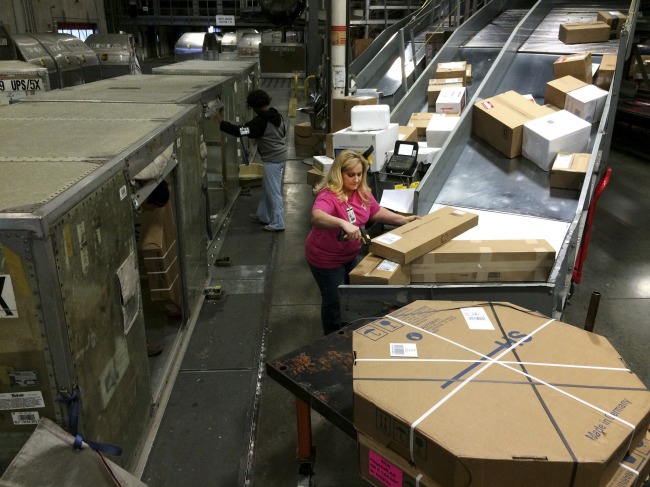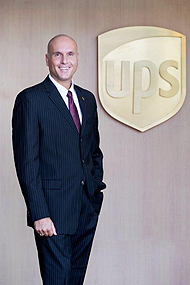UPS eyes e-commerce as growth engine in Asia-Europe shipping
As Asian consumers increasingly buy overseas, UPS seeks to increase its competitiveness with improved technology
By Korea HeraldPublished : Sept. 18, 2016 - 18:32
BRUSSELS -- The world’s largest package delivery company is looking to transcontinental shipping and the rise of e-commerce as growth engines, according to the chief executive of the company’s European branch.
Nando Cesarone, CEO of United Parcel Service Europe, told a group of Asian reporters at UPS Europe’s headquarters in Brussels that the rise of e-commerce and the increasing preference among consumers to shop online and across borders were creating a shift in transcontinental shipping trends.
Nando Cesarone, CEO of United Parcel Service Europe, told a group of Asian reporters at UPS Europe’s headquarters in Brussels that the rise of e-commerce and the increasing preference among consumers to shop online and across borders were creating a shift in transcontinental shipping trends.

“As spending power continues to increase in Asia, you start to see European customers alike more interested in shipping their goods to Asia. A lot of high-luxury brands are manufactured and sitting here in Europe,” he said. “It’s going backwards now. It used to be Asia shipping (to Europe), but that balance is starting to even itself out a little bit.”
E-commerce has been a boon to shipping companies everywhere as more customers seek out delivery options for products they would have previously purchased in-store. However, Asia is a particularly interesting region for global shipping companies such as UPS because of its fast-growing population of online shoppers as well as those who buy from abroad -- particularly purchases of high-end products.
“Luxury brands are interesting for us, as well as established brands,” said Craig Arnold, vice president of sales at UPS Europe. “Luxury brands want to deal with a trusted brand for the delivery part, because it’s an extension of their brand. We’re a good fit in the luxury market when a well-uniformed, on-time driver shows up at the door.”
According to data from the international nonprofit organization Ecommerce Foundation last year, Asia-Pacific was the fastest-growing e-commerce region in 2014 at 44.3 percent. Shipping demand followed consumer demand, with Asia-Pacific having the largest compounded annual growth rate of all regions served by UPS, according to UPS Asia-Pacific spokeswoman Cheri Chow.
To prepare for increased demand in the region, UPS is extending investments and technologies to the region to bring it up to par with its older American and European operations. According to UPS’ International Public Relations Director Gregg Svingen, UPS invests roughly “$100,000 per hour” in technology, including not only those that help bring about improvements in transit times, but also solutions for sensitive sectors such as health care. Reuters recently reported that UPS was considering the launch of a 3-D printing facility in Singapore and Japan, expanding services it already offers in other regions.
“Technology links to everything else from a customer point of view,” said Cesarone. “Window-of-time delivery, providing time of arrival for a driver, which we started in the US ... all those technologies exist, and the short answer is that we’ve got some deployed in Asia.”
Every night, a Boeing 747 -- the largest plane in the UPS fleet that flies out of the company’s European hub -- carries cargo to Asia from the hub in Cologne, Germany. Although UPS representatives declined to comment on how much cargo flying into Asia’s hub in Shenzhen, China from Europe has increased with the rise of e-commerce, the growth was described as being “significant.”
The importance of that growth has been visible in Asia as well. Just in Korea, UPS expanded its hub at Incheon International Airport to 9,000 square meters, increasing its capacity by 60 percent in 2014.
E-commerce has been a boon to shipping companies everywhere as more customers seek out delivery options for products they would have previously purchased in-store. However, Asia is a particularly interesting region for global shipping companies such as UPS because of its fast-growing population of online shoppers as well as those who buy from abroad -- particularly purchases of high-end products.
“Luxury brands are interesting for us, as well as established brands,” said Craig Arnold, vice president of sales at UPS Europe. “Luxury brands want to deal with a trusted brand for the delivery part, because it’s an extension of their brand. We’re a good fit in the luxury market when a well-uniformed, on-time driver shows up at the door.”
According to data from the international nonprofit organization Ecommerce Foundation last year, Asia-Pacific was the fastest-growing e-commerce region in 2014 at 44.3 percent. Shipping demand followed consumer demand, with Asia-Pacific having the largest compounded annual growth rate of all regions served by UPS, according to UPS Asia-Pacific spokeswoman Cheri Chow.
To prepare for increased demand in the region, UPS is extending investments and technologies to the region to bring it up to par with its older American and European operations. According to UPS’ International Public Relations Director Gregg Svingen, UPS invests roughly “$100,000 per hour” in technology, including not only those that help bring about improvements in transit times, but also solutions for sensitive sectors such as health care. Reuters recently reported that UPS was considering the launch of a 3-D printing facility in Singapore and Japan, expanding services it already offers in other regions.
“Technology links to everything else from a customer point of view,” said Cesarone. “Window-of-time delivery, providing time of arrival for a driver, which we started in the US ... all those technologies exist, and the short answer is that we’ve got some deployed in Asia.”
Every night, a Boeing 747 -- the largest plane in the UPS fleet that flies out of the company’s European hub -- carries cargo to Asia from the hub in Cologne, Germany. Although UPS representatives declined to comment on how much cargo flying into Asia’s hub in Shenzhen, China from Europe has increased with the rise of e-commerce, the growth was described as being “significant.”
The importance of that growth has been visible in Asia as well. Just in Korea, UPS expanded its hub at Incheon International Airport to 9,000 square meters, increasing its capacity by 60 percent in 2014.

However, as Cesarone noted, such improvements in UPS’ services “don’t come for free,” and the CEO acknowledged that prices will likely go up -- potentially making competition tougher in markets such as Korea where consumers already have a wide selection of shipping companies to choose from, including services that will provide foreign addresses and bulk shipping for consumers buying directly from retailers abroad.
However, UPS remains optimistic. “Competition is good,” said Cesarone. “Our challenge is helping customers get more value out of us and staying ahead of competition. That means enhanced services, faster delivery. That means more technology, different customized solutions on getting merchandise to market. We just have to be better than the competition.”
By Won Ho-jung (hjwon@heraldcorp.com) / Korea Herald correspondent
However, UPS remains optimistic. “Competition is good,” said Cesarone. “Our challenge is helping customers get more value out of us and staying ahead of competition. That means enhanced services, faster delivery. That means more technology, different customized solutions on getting merchandise to market. We just have to be better than the competition.”
By Won Ho-jung (hjwon@heraldcorp.com) / Korea Herald correspondent
-
Articles by Korea Herald





![[Herald Interview] 'Amid aging population, Korea to invite more young professionals from overseas'](http://res.heraldm.com/phpwas/restmb_idxmake.php?idx=644&simg=/content/image/2024/04/24/20240424050844_0.jpg&u=20240424200058)












![[KH Explains] Korean shipbuilding stocks rally: Real growth or bubble?](http://res.heraldm.com/phpwas/restmb_idxmake.php?idx=652&simg=/content/image/2024/04/25/20240425050656_0.jpg&u=)

